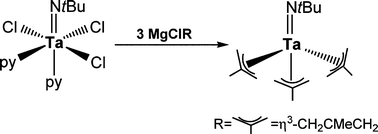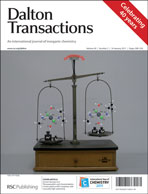Pseudooctahedral complexes [MCl3(NtBu)L2] (M = Nb, L = py 1, ½ tmeda 3; M = Ta, L = py 2, ½ tmeda 4) have been studied by spectroscopic methods. By a VT 1H NMR experiment a mutual exchange process between the pyax and pyfree in the complexes 1–2 was observed, whereas 13C and 15N NMR studies showed in the complexes 3–4 a tmeda ligand with an axial/equatorial coordination mode. The reaction of 2 with 3 equiv of Grignard reagent produces the methathesis products [TaR3(NtBu)] (R = CH2CMeCH25, CH2CHCHCH36) in which 2-methylallyl and 2-butenyl groups appear with a η3- and σ-coordination mode, respectively. When, toluene solutions of the compounds 5–6 were treated with 2 equiv of 2,6-dimethylphenylisocyanide the imido bisiminoacyl compounds [TaR(NtBu){C(R)NAr-κ1C}2] (Ar = 2,6-Me2C6H3; R = CH2CMeCH27, CH2CHCHCH38) can be isolated, via an imido iminoacyl intermediate [TaR2(NtBu){C(R)NAr-κ1C}] (Ar = 2,6-Me2C6H3; R = CH2CMeCH29) as we have observed in the treatment of 5 with 1 equiv of isocyanide; however, the analogous reaction between 5 and COPh2 leads to the formation of the trisalkoxo imido compound [Ta(OCPh2R)3(NtBu)] (R = CH2CMeCH210). All new complexes were studied by IR and multinuclear NMR spectroscopy.

You have access to this article
 Please wait while we load your content...
Something went wrong. Try again?
Please wait while we load your content...
Something went wrong. Try again?


 Please wait while we load your content...
Please wait while we load your content...